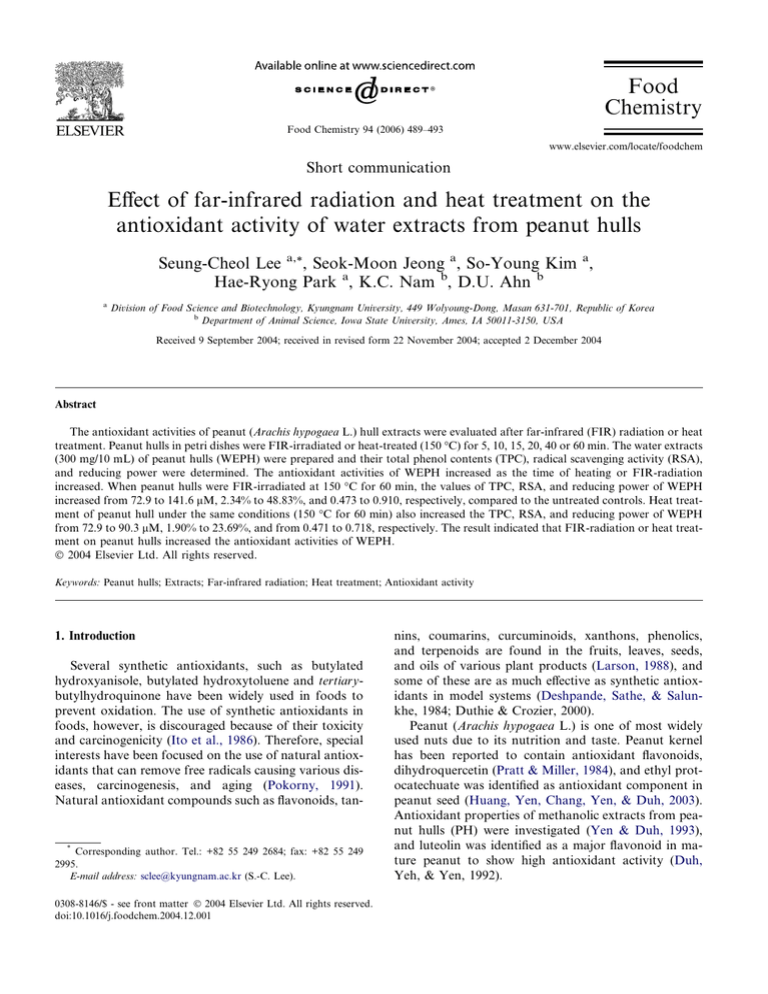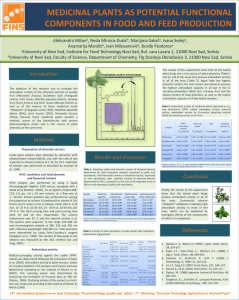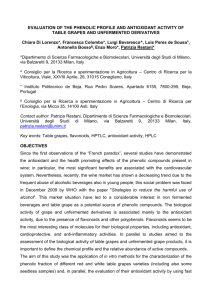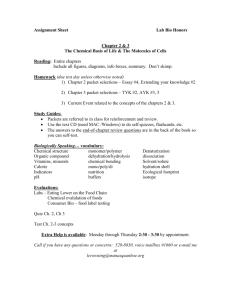
Food
Chemistry
Food Chemistry 94 (2006) 489–493
www.elsevier.com/locate/foodchem
Short communication
Effect of far-infrared radiation and heat treatment on the
antioxidant activity of water extracts from peanut hulls
Seung-Cheol Lee a,*, Seok-Moon Jeong a, So-Young Kim a,
Hae-Ryong Park a, K.C. Nam b, D.U. Ahn b
a
Division of Food Science and Biotechnology, Kyungnam University, 449 Wolyoung-Dong, Masan 631-701, Republic of Korea
b
Department of Animal Science, Iowa State University, Ames, IA 50011-3150, USA
Received 9 September 2004; received in revised form 22 November 2004; accepted 2 December 2004
Abstract
The antioxidant activities of peanut (Arachis hypogaea L.) hull extracts were evaluated after far-infrared (FIR) radiation or heat
treatment. Peanut hulls in petri dishes were FIR-irradiated or heat-treated (150 C) for 5, 10, 15, 20, 40 or 60 min. The water extracts
(300 mg/10 mL) of peanut hulls (WEPH) were prepared and their total phenol contents (TPC), radical scavenging activity (RSA),
and reducing power were determined. The antioxidant activities of WEPH increased as the time of heating or FIR-radiation
increased. When peanut hulls were FIR-irradiated at 150 C for 60 min, the values of TPC, RSA, and reducing power of WEPH
increased from 72.9 to 141.6 lM, 2.34% to 48.83%, and 0.473 to 0.910, respectively, compared to the untreated controls. Heat treatment of peanut hull under the same conditions (150 C for 60 min) also increased the TPC, RSA, and reducing power of WEPH
from 72.9 to 90.3 lM, 1.90% to 23.69%, and from 0.471 to 0.718, respectively. The result indicated that FIR-radiation or heat treatment on peanut hulls increased the antioxidant activities of WEPH.
2004 Elsevier Ltd. All rights reserved.
Keywords: Peanut hulls; Extracts; Far-infrared radiation; Heat treatment; Antioxidant activity
1. Introduction
Several synthetic antioxidants, such as butylated
hydroxyanisole, butylated hydroxytoluene and tertiarybutylhydroquinone have been widely used in foods to
prevent oxidation. The use of synthetic antioxidants in
foods, however, is discouraged because of their toxicity
and carcinogenicity (Ito et al., 1986). Therefore, special
interests have been focused on the use of natural antioxidants that can remove free radicals causing various diseases, carcinogenesis, and aging (Pokorny, 1991).
Natural antioxidant compounds such as flavonoids, tan-
*
Corresponding author. Tel.: +82 55 249 2684; fax: +82 55 249
2995.
E-mail address: sclee@kyungnam.ac.kr (S.-C. Lee).
0308-8146/$ - see front matter 2004 Elsevier Ltd. All rights reserved.
doi:10.1016/j.foodchem.2004.12.001
nins, coumarins, curcuminoids, xanthons, phenolics,
and terpenoids are found in the fruits, leaves, seeds,
and oils of various plant products (Larson, 1988), and
some of these are as much effective as synthetic antioxidants in model systems (Deshpande, Sathe, & Salunkhe, 1984; Duthie & Crozier, 2000).
Peanut (Arachis hypogaea L.) is one of most widely
used nuts due to its nutrition and taste. Peanut kernel
has been reported to contain antioxidant flavonoids,
dihydroquercetin (Pratt & Miller, 1984), and ethyl protocatechuate was identified as antioxidant component in
peanut seed (Huang, Yen, Chang, Yen, & Duh, 2003).
Antioxidant properties of methanolic extracts from peanut hulls (PH) were investigated (Yen & Duh, 1993),
and luteolin was identified as a major flavonoid in mature peanut to show high antioxidant activity (Duh,
Yeh, & Yen, 1992).
490
S.-C. Lee et al. / Food Chemistry 94 (2006) 489–493
Many antioxidant phenolic compounds in plants,
however, are most frequently present as covalently
bound form with insoluble polymers (Niwa & Miyachi,
1986; Peleg, Naim, Rouseff, & Zehavi, 1991). Therefore,
it is necessary to find effective processing methods to liberate the natural antioxidant compounds from plant
sources. Previously we reported that far-infrared (FIR)
radiation or simple heat treatment could liberate and
activate low-molecular-weighted natural antioxidants
in plants (Jeong et al., 2004; Jeong, Kim, Kim, Jo
et al., 2004; Lee et al., 2003). The objective of this research
was to determine the antioxidant activities of FIR-radiated or heat-treated peanut hull extracts.
1 filter paper. The distilled water extract of PH (WEPH)
was used to determine the antioxidant activities.
2. Materials and methods
2.5. DPPH radical scavenging activity
2.1. Materials
The DPPH radical scavenging activity of WEPH was
estimated according to the method of Blois (1958). After
mixing 0.1 mL of WEPH with 0.9 mL of 0.041 mM
DPPH in ethanol for 10 min, the absorbance of the sample was measured at 517 nm. Radical scavenging activity
was expressed as percentage according to the following
formula:
Peanuts (A. hypogaea L.) were purchased from a local
market (Masan, Korea) and divided into hulls and edible parts. The peanut hulls (PH) were stored at 4 C until used. Tannic acid, and 1,1-diphenyl-2-picrylhydrazyl
(DPPH) were purchased from Sigma Chemical Co.
(St. Louis, MO, USA) and Folin–Ciocalteu reagent
from Wako Pure Chemical Industries, Ltd. (Osaka, Japan). Other reagents were all of analytical grade and
used as received.
2.4. Total phenolic contents
The total phenolic contents (TPC) of WEPH was
determined according to the method of Gutfinger
(1981). One mL of WEPH was mixed with 1 mL of
the 50% Folin–Ciocalteu reagent and 1 mL of 2%
Na2CO3, and then centrifuged at 13,400g for 5 min.
After 30 min incubation at room temperature, the
absorbance was measured with a spectrophotometer
(Shimadzu UV-1601, Tokyo, Japan) at 750 nm. TPC
were expressed as tannic acid equivalents.
%DPPH radical scavenging activity
¼ ð1 sample OD=control ODÞ 100
2.2. Far-infrared radiation or heat treatment
2.6. Reducing power
PH were dried under room temperature and finely
ground using a blender (MC-811C, Novita, Korea).
The milled PH (1 g) was placed as a thin layer in a Pyrex
petri dish (8.0 cm diameter) and irradiated using a FIR
heater (35 · 10 cm, output 300 W, Hakko Electric Machine Works Co., Ltd., Nagano, Japan), which emitted
radiation at the wavelength range from 2 to 14 lm in
a FIR-dryer (A-Sung Tester, Korea). A sample holding
tray in the middle of FIR-dryer was placed to face the
FIR heater with rotation for even irradiation. FIR-radiation was carried out with separate batches for 5, 10, 15,
20, 40 or 60 min at a controlled temperature of 150 C.
In case of heat treatment, PH was roasted in an electric
muffle furnace (Model DMF-802, Daeil Engineering,
Korea) under the same conditions of FIR-radiation.
After heating, PH was allowed to cool to ambient temperature before extraction.
The reducing power of WEPH was determined
according to the method of Oyaizu (1986). WEPH (1
mL), phosphate buffer (1 mL, 0.2 M, pH 6.6) and potassium ferricyanide (1.0 mL, 10 mg/mL) were mixed together and incubated at 50 C for 20 min.
Trichloroacetic acid (1.0 mL, 100 mg/mL) was added
to the mixture and centrifuged at 13,400g for 5 min.
The supernatant (1.0 mL) was mixed with distilled water
(1.0 mL) and ferric chloride (0.1 mL, 1.0 mg/mL), and
then the absorbance was measured at 700 nm.
2.3. Preparation of water extracts from PH
FIR-irradiated or heat-treated PH (0.3 g) was extracted with 10 mL of distilled water in a shaking incubator (100 rpm) at room temperature overnight. Then
the extracts were centrifuged at 1000g for 15 min and
the supernatants were filtered through a Whatman No.
2.7. Gas chromatography/mass spectrometry analysis of
PH extracts
Extracts from untreated and treated (150 C for 60
min) PH were dissolved in ethanol (200 mg/mL) and
centrifuged at 13,400g for 5 min to precipitate undissolved materials. The supernatant was mixed with 4 volumes of BSA [N,O-bis(trimethylsilyl)acetamide] and
derivatized in a water bath (70 C) for 15 min (Du &
Ahn, 2002). The compounds in PH extracts were identified using a gas chromatograph/mass spectrometer
(GC6890/MS5973, Hewlett–Packard Co., Wilmington,
DE). A split inlet (99:1) was used to inject sample (5
lL) into an HP-5 column (30 m, 0.32 mm i.d., 0.25
S.-C. Lee et al. / Food Chemistry 94 (2006) 489–493
491
crease phenolic contents from WEPH than simple heating. FIR rays are defined as electromagnetic waves
which have wavelengths longer than 4 lm but shorter
than microwave (k > 0.1 cm). FIR rays are biologically
active (Inoue & Kabaya, 1989) and transfer heat to
the center of materials evenly without degrading the
constituent molecules of surface (Niwa, Kanoh, Kasama, & Neigishi, 1988). FIR may have capability to
cleave covalent bonds and liberate antioxidants such
as flavonoids, carotene, tannin, ascorbate, flavoprotein
or polyphenols from repeating polymers (Niwa et al.,
1988). Our previous study (Lee et al., 2003) showed that
simple heat treatments could not cleave covalently
bound phenolic compounds from rice hulls but FIR
treatments could. On the other hand, simple heat treatments increased the TPC of defatted sesame meals
(Jeong et al., 2004) and citrus peels (Jeong, Kim, Kim,
Jo et al., 2004). This indicated that phenolic compounds
of plants should be present in different binding status
depending on plant species. Thus, effective processing
steps to liberate antioxidant compounds from different
plants may not be the same.
Radical scavengers were evaluated by their reactivity
toward a stable free radical, DPPH. DPPH radical scavenging activities (RSA) of WEPH also significantly increased with FIR-radiation (Table 2). After FIR
radiation for 60 min, the percentage of RSA increased
from 2.34% to 48.33%. Though simple heating also increased the RSA to 23.69%, the increasing activity was
lower than that of FIR-radiation. The increase of RSA
was also dependent upon the exposure time to FIR-radiation or heat.
The power of certain antioxidants is associated with
their reducing power (Jayaprakasha, Singh, & Sakariah,
2001), which is associated with the presence of reductones (Duh, 1998). The reducing power of WEPH increased significantly by FIR-radiation or heat
treatment (Table 3). The reducing power of WEPH increased from 0.473 to 0.910 by FIR radiation for 60
min at 150 C and to 0.718 by heating at the same heating time and temperature conditions.
Methanolic extract from PH showed a strong antioxidant activity in fried potato chips (Rehman, 2003).
However, to use the extracts of PH as an antioxidant
lm film; Hewlett–Packard Co., Wilmington, DE). A
ramped oven temperature was used (100 C for 2 min,
increased to 270 C at 10 C/min, and held for 6 min).
The inlet temperature was 250 C and the carrier gas
was helium at 1.5 mL/min. The ionization potential of
mass selective detector was 70 eV and the scan range
was 19.1–400 m/z. Identification of compounds detected
was achieved by comparing mass spectral data of samples with those of the Wiley library (Hewlett–Packard
Co.).
2.8. Statistical analysis
All measurements were done in triplicate, and analysis of variance was conducted by the procedure of general linear model using SAS software (SAS Institute,
1995). Student–Newman–KeulÕs multiple range tests
were used to compare the differences of the mean values
among treatments (P < 0.05).
3. Results and discussion
Phenolic compounds are the most active antioxidant
derivatives in plants (Bors, Michel, & Stettmaier, 2001).
They are known to act as antioxidants not only because
of their ability to donate hydrogen or electrons but also
because they are stable radical intermediates (Cuvelier,
Richard, & Berset, 1992; Maillard, Soum, Boivia, & Berset, 1996). Generally, the outer layers of plant such as
peel, shell, and hull contain large amount of polyphenolic compounds to protect inner materials. A number of
phenolic acids are linked to various cell wall components such as arabinoxylans and proteins (Harris &
Hartley, 1976; Hartley, Morrison, Himmelsbach, &
Borneman, 1990). Duh et al. (1992) identified luteolin,
a flavonoid which has a strong antioxidant activity,
from methanolic extract from PH.
The TPC in WEPH increased significantly by FIRradiation or heat treatment and the increase was timedependent (Table 1). The TPC of WEPH was increased
from 72.9 lM in unheated control to 141.6 lM by FIRradiation and to 90.3 by heating at 150 C for 60 min.
Therefore, FIR radiation of PH was more efficient to in-
Table 1
Effect of FIR-radiation and heat treatments on total phenolic contents of water extract from peanut hulls (WEPH) (unit: lM)
SEMA
Time (min)
0
FIR-radiation
Heat treatment
SEMA
a–e
5
e
72.9
72.9c
0.2
10
de
79.3
79.8b
0.2
15
d
88.6
79.5b
0.3
99.4
78.6by
0.2
Different letters within a row are significantly different (P < 0.05), n = 3.
Different letters within a column are significantly different (P < 0.05).
A
Standard error of the means.
x–y
20
cx
40
cx
107.8
78.5by
0.4
60
bx
124.1
86.7ay
0.3
141.6ax
90.3ay
0.2
0.3
0.1
492
S.-C. Lee et al. / Food Chemistry 94 (2006) 489–493
Table 2
Effect of FIR-radiation and heat treatments on the radical scavenging activity of water extract from peanut hulls (WEPH) (unit: %)
SEMA
Time (min)
FIR-radiation
Heat treatment
SEMA
0
5
10
15
20
40
60
2.34f
1.90c
0.51
6.25f
11.32b
1.35
14.68e
18.62a
1.90
26.21d
19.35a
1.98
33.42cx
16.13aby
2.51
43.39bx
19.78ay
2.35
48.83ax
23.69ay
1.14
1.73
1.87
a–f
Different letters within a row are significantly different (P < 0.05), n = 3.
Different letters within a column with same color value are significantly different (P < 0.05).
A
Standard error of the means.
x–y
Table 3
Effect of FIR-radiation and heat treatments on the reducing power of water extract from peanut hulls (WEPH) (unit: Absorbance)
SEMA
Time (min)
FIR-radiation
Heat treatment
SEMA
0
5
10
15
20
40
60
0.473e
0.471d
0.007
0.460ex
0.493cdy
0.007
0.558d
0.533c
0.007
0.695cx
0.554cy
0.009
0.704cx
0.552cy
0.007
0.794bx
0.659by
0.019
0.910ax
0.718ay
0.015
0.005
0.015
a–e
Different letters within a row are significantly different (P < 0.05), n = 3.
Different letters within a column with same color value are significantly different (P < 0.05).
A
Standard error of the means.
x–y
in foods, methanol should be substituted with some
harmless solvent. Although water is not as effective as
organic solvents to extract useful compounds from
plants, it can be a good candidate when an appropriate
processing such as FIR-radiation or heating is
combined.
Different types of phenolic compounds were detected
in water extracts of peanut hulls by gas chromatograph/
mass spectrometer (Table 4). Compared to unheated extract, the extract from heat-treated or FIR-radiated PH
had more versatile phenolic compounds. 4-hydroxy-3methoxy benzaldehyde, 4-hydroxy-3-methoxy benzoic
acid, and 4-hydroxy-3-methyl benzenacetic acid were
newly detected in roasted peanut hull extract. The
amounts of 2-methoxy phenol increased in the order
of control, roasted, and FIR-radiated samples. FIRradiated peanut extract had greater number and higher
amounts of phenolics than heat-treated ones. The results
are very credible when they were compared with the
antioxidant activities shown in Tables 2 and 3. There-
Table 4
Representative phenolic compounds of water extract from peanut hulls (WEPH) affected by FIR-radiation and heat treatments at 150 C for 60 min
Total ion counts (·104)
RT
Compound
Untreated
4.23
7.24
10.98
2-Methoxy phenol
2-Methoxy-5-vinyl phenol
4-Hydroxy-3-methoxy benzenacetic acid
217
55
143
Roasted
7.24
9.12
10.95
11.77
14.02
2-Methoxy-5-vinyl phenol
4-Hydroxy-3-methoxy benzaldehyde
4-Hydroxy-3-methoxy benzenacetic acid
4-Hydroxy-3-methoxy benzoic acid
4-Hydroxy-3-methyl benzenacetic acid
253
197
168
93
120
FIR-radiated
4.29
4.33
7.24
9.12
9.52
10.98
11.06
14.40
2-Methoxy phenol
2-Hydroxy-4-methoxy benzoic acid
2-Methoxy-5-vinyl phenol
4-Hydroxy-3-methoxy benzaldehyde
2,4-Bis(1,1-dimethylethyl) phenol
4-Hydroxy-3-methoxy benzenacetic acid
Vanillyl alcohol
Methyl cinnamate
1736
1617
143
795
446
115
75
152
S.-C. Lee et al. / Food Chemistry 94 (2006) 489–493
fore, it was concluded that FIR-radiation was more
effective way than simple heat treatments in making
the antioxidant phenolic compounds in peanut hulls
active.
Acknowledgements
This study was supported by research fund from
Kyungnam University, Korea. S.-M.J. and S.-Y.K. were
financially supported by Brain Korea 21 Program.
References
Blois, M. S. (1958). Antioxidant determination by the use of a stable
free radical. Nature, 181, 1199–1200.
Bors, W., Michel, C., & Stettmaier, K. (2001). Structure–activity
relationships governing antioxidant capacities of plant polyphenols. Methods in Enzymology, 335, 166–180.
Cuvelier, M. E., Richard, H., & Berset, C. (1992). Comparison of the
antioxidant activity of some acid phenols: structure–activity
relationship. Bioscience, Biotechnology, and Biochemistry, 56,
324–325.
Deshpande, S. S., Sathe, S. K., & Salunkhe, D. K. (1984). Chemistry
and safety of plant polyphenols. In M. Friedman (Ed.), Nutritional
and toxicologial aspects of food safety (pp. 457–495). New York:
Plenum Press.
Du, M., & Ahn, D. U. (2002). Simultaneous analysis of tocopherols,
cholesterol and phytoterols by gas chromatography. Journal of
Food Science, 67, 1696–1700.
Duh, P. D. (1998). Antioxidant activity of budrock (Arctium lappa L.):
its scavenging effect on free radical and active oxygen. Journal of
the American Oil Chemists Society, 75, 455–461.
Duh, P. D., Yeh, D. B., & Yen, G. C. (1992). Extraction and
identification of an antioxidative component from peanut hulls.
Journal of the American Oil Chemists Society, 69, 814–818.
Duthie, G., & Crozier, A. (2000). Plant-derived phenolic antioxidants.
Current Opinion in Lipidology, 11, 43–47.
Gutfinger, T. (1981). Polyphenols in olive oils. Journal of the American
Oil Chemists Society, 58, 966–968.
Harris, P. J., & Hartley, R. D. (1976). Detection of bound ferulic acid
in cell walls of the gramineae by ultraviolet fluorescent microscopy.
Nature, 259, 508–510.
Hartley, R. D., Morrison, W. H., Himmelsbach, D. S., & Borneman,
N. S. (1990). Cross-linking of cell wall phenolics to arabinoxylans
in graminaceous plants. Phytochemistry, 29, 3701–3709.
Huang, S. C., Yen, G. C., Chang, L. W., Yen, W. J., & Duh, P. D.
(2003). Identification of an antioxidant, ethyl protocatechuate, in
peanut seed testa. Journal of Agricultural and Food Chemistry, 51,
2380–2383.
493
Inoue, S., & Kabaya, M. (1989). Biological activities caused by farinfrared radiation. International Journal of Biometeorology, 33,
145–150.
Ito, N., Hirose, M., Fukushima, G., Tauda, H., Shira, T., &
Tatematsu, M. (1986). Studies on antioxidant. Their carcinogenic
and modifying effects on chemical carcinogenesis. Food and
Chemical Toxicology, 24, 1071–1081.
Jayaprakasha, G. K., Singh, R. P., & Sakariah, K. K. (2001).
Antioxidant activity of grape seed (Vitis vinifera) extracts on
peroxidation models in vitro. Food Chemistry, 73, 285–290.
Jeong, S. M., Kim, S. Y., Kim, D. R., Nam, K. C., Ahn, D. U., & Lee,
S. C. (2004). Effect of seed roasting conditions on the antioxidant
activity of defatted sesame meal extracts. Journal of Food Science,
69, 377–381.
Jeong, S. M., Kim, S. Y., Kim, D. R., Jo, S. C., Nam, K. C., Ahn, D.
U., et al. (2004). Effect of heat treatment on antioxidant activity of
citrus peels. Journal of Agricultural and Food Chemistry, 52,
3389–3393.
Larson, R. A. (1988). The antioxidants of higher plants. Phytochemistry, 27, 969–978.
Lee, S. C., Kim, J. H., Jeong, S. M., Kim, D. R., Ha, J. U., Nam, K.
C., et al. (2003). Effect of far-infrared radiation on the antioxidant
activity of rice hulls. Journal of Agricultural and Food Chemistry,
51, 4400–4403.
Maillard, M. N., Soum, M. H., Boivia, P., & Berset, C. (1996).
Antioxidant activity of barley and malt: relationship with
phenolic content. Lebensmittel-Wissenschaft Und-Technologie, 29,
238–244.
Niwa, Y., Kanoh, T., Kasama, T., & Neigishi, M. (1988). Activation
of antioxidant activity in natural medicinal products by heating,
brewing and lipophilization. A new drug delivery system. Drugs
under Experimental and Clinical Research, 14, 361–372.
Niwa, Y., & Miyachi, Y. (1986). Antioxidant action of natural health
products and Chinese herbs. Inflammation, 10, 79–97.
Oyaizu, M. (1986). Studies on products of browning reaction:
antioxidative activities of products of browning reaction prepared
from glucosamine. Japanese Journal of Nutrition, 44, 307–315.
Peleg, H., Naim, M., Rouseff, R. L., & Zehavi, U. (1991). Distribution
of bound and free phenolic acids in oranges (Citrus sinensis) and
grapefruit (Citrus paradisi). Journal of the Science of Food and
Agriculture, 57, 417–426.
Pokorny, J. (1991). Natural antioxidant for food use. Trends in Food
Science and Technology, 9, 223–227.
Pratt, D. E., & Miller, E. E. (1984). A flavonoid antioxidant in Spanish
peanuts (Arachia hypogoea). Journal of the American Oil Chemists
Society, 61, 1064–1067.
Rehman, Z. U. (2003). Evaluation of antioxidant activity of methanolic extract from peanut hulls in fried potato chips. Plant Foods for
Human Nutrition, 58, 75–83.
SAS Institute. (1995). SAS/STAT UserÕs guide. Cary, NC: SAS
Institute Inc.
Yen, G. C., & Duh, P. D. (1993). Antioxidative properties of
methanolic extracts from peanut hulls. Journal of the American
Oil Chemists Society, 70, 383–386.









